 W
WElectric power distribution is the final stage in the delivery of electric power; it carries electricity from the transmission system to individual consumers. Distribution substations connect to the transmission system and lower the transmission voltage to medium voltage ranging between 2 kV and 35 kV with the use of transformers. Primary distribution lines carry this medium voltage power to distribution transformers located near the customer's premises. Distribution transformers again lower the voltage to the utilization voltage used by lighting, industrial equipment and household appliances. Often several customers are supplied from one transformer through secondary distribution lines. Commercial and residential customers are connected to the secondary distribution lines through service drops. Customers demanding a much larger amount of power may be connected directly to the primary distribution level or the subtransmission level.
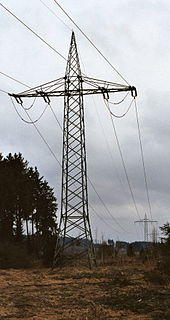 W
WRailway electrification systems using alternating current (AC) at 15 kilovolts (kV) and 16.7 Hertz (Hz) are used on transport railways in Germany, Austria, Switzerland, Sweden, and Norway. The high voltage enables high power transmission with the lower frequency reducing the losses of the traction motors that were available at the beginning of the 20th century. Railway electrification in late 20th century tends to use 25 kV, 50 Hz AC systems which has become the preferred standard for new railway electrifications but extensions of the existing 15 kV networks are not completely unlikely. In particular, the Gotthard Base Tunnel still uses 15 kV, 16.7 Hz electrification.
 W
WAn aerial cable or air cable is an insulated cable usually containing all conductors required for an electrical distribution system or a telecommunication line, which is suspended between utility poles or electricity pylons. As aerial cables are completely insulated there is no danger of electric shock when touching them and there is no requirement for mounting them with insulators on pylons and poles. A further advantage is they require less right of way than overhead lines for the same reason. They can be designed as shielded cables for telecommunication purposes. If the cable falls, it may still operate if its insulation is not damaged.
 W
WAmtrak's 25 Hz traction power system is a traction power grid operated by Amtrak along the southern portion of its Northeast Corridor (NEC): the 225 route miles (362 km) between Washington, D.C. and New York City and the 104 route miles (167 km) between Philadelphia and Harrisburg, Pennsylvania. The Pennsylvania Railroad constructed it between 1915 and 1938. Amtrak inherited the system from Penn Central, the successor to Pennsylvania Railroad, in 1976 along with the Northeast Corridor. This is the reason for using 25 Hz, as opposed to 60 Hz, which is the standard for power transmission in North America. In addition to serving the NEC, the system provides power to NJ Transit Rail Operations (NJT), the Southeastern Pennsylvania Transportation Authority (SEPTA) and the Maryland Area Regional Commuter Train (MARC). Only about half of the system's electrical capacity is used by Amtrak. The remainder is sold to the commuter railroads who operate their trains along the corridor.
 W
WIn an electric power system, automatic generation control (AGC) is a system for adjusting the power output of multiple generators at different power plants, in response to changes in the load. Since a power grid requires that generation and load closely balance moment by moment, frequent adjustments to the output of generators are necessary. The balance can be judged by measuring the system frequency; if it is increasing, more power is being generated than used, which causes all the machines in the system to accelerate. If the system frequency is decreasing, more load is on the system than the instantaneous generation can provide, which causes all generators to slow down.
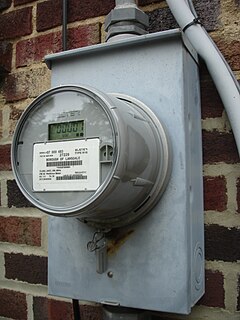 W
WAutomatic meter reading (AMR) is the technology of automatically collecting consumption, diagnostic, and status data from water meter or energy metering devices and transferring that data to a central database for billing, troubleshooting, and analyzing. This technology mainly saves utility providers the expense of periodic trips to each physical location to read a meter. Another advantage is that billing can be based on near real-time consumption rather than on estimates based on past or predicted consumption. This timely information coupled with analysis can help both utility providers and customers better control the use and production of electric energy, gas usage, or water consumption.
 W
WAvailability Based Tariff (ABT) is a frequency based pricing mechanism applicable in India for unscheduled electric power transactions. The ABT falls under electricity market mechanisms to charge and regulate power to achieve short term and long term network stability as well as incentives and dis-incentives to grid participants against deviations in committed supplies as the case may be.
 W
WCable fault location is the process of locating periodic faults, such as insulation faults in cables. In this process, mobile shock discharge generators are among the devices used.
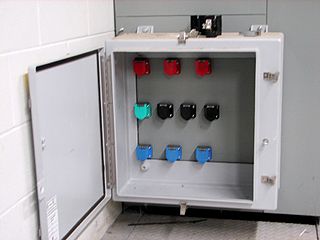 W
WA camlock, or also cam lock and Cam-Lok, is an interchangeable single-pole electrical connector often used in temporary electrical power production and distribution predominantly used in North America. Originally a trade name as Cam-Lok, it is now a generic term.
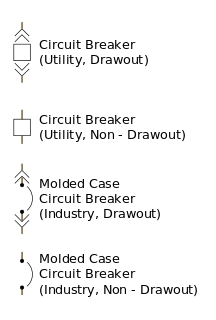 W
WA circuit breaker is an automatically operated electrical switch designed to protect an electrical circuit from damage caused by excess current from an overload or short circuit. Its basic function is to interrupt current flow after a fault is detected. Unlike a fuse, which operates once and then must be replaced, a circuit breaker can be reset to resume normal operation.
 W
WA consumer unit is a type of distribution board.
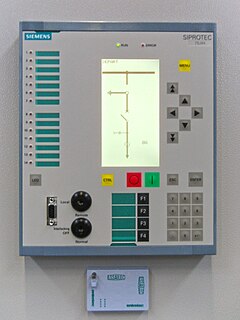 W
WIn utility and industrial electric power transmission and distribution systems, a numerical relay is a computer-based system with software-based protection algorithms for the detection of electrical faults. Such relays are also termed as microprocessor type protective relays. They are functional replacements for electro-mechanical protective relays and may include many protection functions in one unit, as well as providing metering, communication, and self-test functions.
 W
WA distribution transformer or service transformer is a transformer that provides the final voltage transformation in the electric power distribution system, stepping down the voltage used in the distribution lines to the level used by the customer. The invention of a practical efficient transformer made AC power distribution feasible; a system using distribution transformers was demonstrated as early as 1882.
 W
WA distributor is an enclosed rotating shaft used in spark-ignition internal combustion engines that have mechanically timed ignition. The distributor's main function is to route secondary, or high voltage, current from the ignition coil to the spark plugs in the correct firing order, and for the correct amount of time. Except in magneto systems and many modern computer controlled engines that use crank angle/position sensors, the distributor also houses a mechanical or inductive breaker switch to open and close the ignition coil's primary circuit.
 W
WAn Earth-leakage circuit breaker (ELCB) is a safety device used in electrical installations with high Earth impedance to prevent shock. It detects small stray voltages on the metal enclosures of electrical equipment, and interrupts the circuit if a dangerous voltage is detected. Once widely used, more recent installations instead use residual-current devices which instead detect leakage current directly.
 W
WElectrical disruptions caused by squirrels are common and widespread, and can involve the disruption of power grids. It has been hypothesized that the threat to the internet, infrastructure and services posed by squirrels may exceed that posed by terrorists. Although many commentators have highlighted humorous aspects of the concern, squirrels have proven consistently able to cripple power grids in many countries, and the danger posed to the electrical grid from squirrels is ongoing and significant This has led to tabulations and maps compiled of the relevant data.
 W
WElectrical equipment includes any machine powered by electricity. It usually consists of an enclosure, a variety of electrical components, and often a power switch. Examples of these include:Lighting Major appliance Small appliances IT equipment Motors, pumps and HVAC Systems
 W
WAn electrical grid, electric grid or power grid, is an interconnected network for delivering electricity from producers to consumers. It consists of:generating stations that produce electric power electrical substations for stepping electrical voltage up for transmission, or down for distribution high voltage transmission lines that carry power from distant sources to demand-centers distribution lines that connect individual customers
 W
WAn electrical room is a room or space in a building dedicated to electrical equipment. Its size is usually proportional to the size of the building; large buildings may have a main electrical room and subsidiary electrical rooms. Electrical equipment may be for power distribution equipment, or for communications equipment.
 W
WElectrical Transient Analyzer Program (ETAP) is an electrical network modeling and simulation software tool used by power systems engineers to create an "electrical digital twin" and analyze electrical power system dynamics, transients and protection.
 W
WElectricity Forward Agreement (calendar) is a calendar used to specify load profiles when trading on the electricity market. It was officially only valid until October 2014, but is still abundantly used among commodity traders.
 W
WElectricity theft is the criminal practice of stealing electrical power. It is a crime and is punishable by fines and/or incarceration. It belongs to the non-technical losses.
 W
WThe New York, New Haven and Hartford Railroad pioneered electrification of main line railroads using high-voltage, alternating current, single-phase overhead catenary. It electrified its mainline between Stamford, Connecticut, and Woodlawn, New York, in 1907, and extended the electrification to New Haven, Connecticut, in 1914. While single-phase AC railroad electrification has become commonplace, the New Haven's system was unprecedented at the time of construction. The significance of this electrification was recognized in 1982 by its designation as a National Historic Engineering Landmark by the American Society of Mechanical Engineers (ASME).
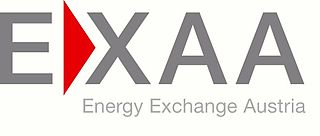 W
WThe Energy Exchange Austria (EXAA) is a Central European energy exchange headquartered in Vienna. Currently, the EXAA Market encompasses trading areas in the entire of Austria and Germany.
 W
WA fault indicator is a device which provides visual or remote indication of a fault on the electric power system. Also called a faulted circuit indicator (FCI), the device is used in electric power distribution networks as a means of automatically detecting and identifying faults to reduce outage time.
 W
WIn electrical distribution, a fuse cutout or cut-out fuse is a combination of a fuse and a switch, used in primary overhead feeder lines and taps to protect distribution transformers from current surges and overloads. An overcurrent caused by a fault in the transformer or customer circuit will cause the fuse to melt, disconnecting the transformer from the line. It can also be opened manually by utility linemen standing on the ground and using a long insulating stick called a "hot stick".
 W
WIn electrical engineering, ground or earth is the reference point in an electrical circuit from which voltages are measured, a common return path for electric current, or a direct physical connection to the earth.
 W
WIn rail transport, head-end power (HEP), also known as electric train supply (ETS), is the electrical power distribution system on a passenger train. The power source, usually a locomotive at the front or 'head' of a train, provides the electricity used for heating, lighting, electrical and other 'hotel' needs. The maritime equivalent is hotel electric power. A successful attempt by the London, Brighton and South Coast Railway in October 1881 to light the passenger cars between London and Brighton heralded the beginning of using electricity to light trains in the world.
 W
WHigh tension leads or high tension cables or spark plug wires or spark plug cables are the wires that connect a distributor, ignition coil, or magneto to each of the spark plugs in some types of internal combustion engine. "High tension lead" or "cable" is also used for any electrical cable carrying a high voltage in any context. Tension in this instance is a synonym for voltage. High tension leads, like many engine components, wear out over time. Each lead contains only one wire, as the current does not return through the same lead, but through the earthed/grounded engine which is connected to the opposite battery terminal. High tension may also be referred to as HT.
 W
WThe International Council on Large Electric Systems (CIGRE) is a global nonprofit organization in the field of high voltage electricity. It was founded in Paris, France in 1921. The scope of its activities include the technical and economical aspects of the electrical grid, as well as the environmental and regulatory aspects.
 W
WA low-voltage network or secondary network is a part of electric power distribution which carries electric energy from distribution transformers to electricity meters of end customers. Secondary networks are operated at a low voltage level, which is typically equal to the mains voltage of electric appliances.
 W
WNational Grid plc is a multinational electricity and gas utility company headquartered in London, England. Its principal activities are in the United Kingdom and in the Northeastern United States. National Grid has a primary listing on the London Stock Exchange, and is a constituent of the FTSE 100 Index. It has a secondary listing on the New York Stock Exchange.
 W
WAn overhead power line is a structure used in electric power transmission and distribution to transmit electrical energy across large distances. It consists of one or more uninsulated electrical cables suspended by towers or poles.
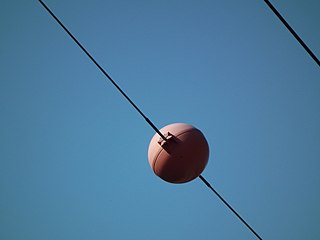 W
WOverhead wire markers are safety instruments applied to the overhead power lines marking transmission lines and ropeways along the flight path during the day.
 W
WPeak demand on an electrical grid is simply the highest electrical power demand that has occurred over a specified time period. Peak demand is typically characterized as annual, daily or seasonal and has the unit of power. Peak demand, peak load or on-peak are terms used in energy demand management describing a period in which electrical power is expected to be provided for a sustained period at a significantly higher than average supply level. Peak demand fluctuations may occur on daily, monthly, seasonal and yearly cycles. For an electric utility company, the actual point of peak demand is a single half-hour or hourly period which represents the highest point of customer consumption of electricity. At this time there is a combination of office, domestic demand and at some times of the year, the fall of darkness.
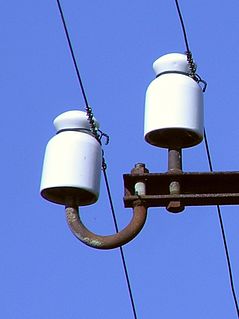 W
WA pin insulator is a device that isolates a wire from a physical support such as a pin on a telegraph or utility pole. It is a formed, single layer shape that is made out of a non-conducting material, usually porcelain or glass. It is thought to be the earliest developed overhead insulator and is still popularly used in power networks up to 33 KV. Single or multiple pin insulators can be used on one physical support, however, the number of insulators used depends upon the application's voltage.
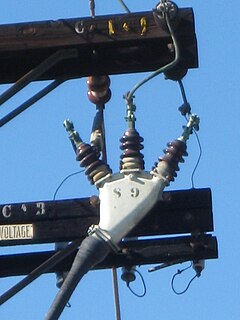 W
WA pothead is a type of insulated electrical terminal used for transitioning between overhead line and underground high-voltage cable or for connecting overhead wiring to equipment like transformers. Its name comes from the process of potting or encapsulation of the conductors inside the terminal's insulating bushing.
 W
WA power box (USA) or feeder pillar (UK) is a cabinet for electrical equipment, mounted in the street and controlling the electrical supply to a number of houses in a neighborhood. A power box is simply a layman's term for a transformer, cutout enclosure, or other enclosure used in conjunction with underground electrical distribution. In the United States, they are often painted olive drab, gray or "sand", a light tan color.
 W
WIn electric power distribution, automatic circuit reclosers (ACRs) are a class of switchgear which is designed for use on overhead electricity distribution networks to detect and interrupt momentary faults. Also known as reclosers or autoreclosers, ACRs are essentially high voltage rated circuit breakers with integrated current and voltage sensors and a protection relay, optimized for use as an overhead network distribution protection asset. Commercial ACRs are governed by the ANSI/IEEE C37.60, IEC 62271-111 and IEC 62271-200 standards. The three major classes of operating voltage are 15.5 kV, 27 kV and 38 kV.
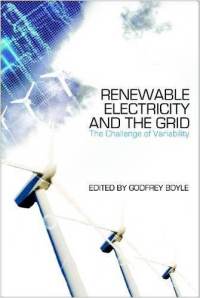 W
WRenewable Electricity and the Grid: The Challenge of Variability is a 2007 book edited by Godfrey Boyle which examines the significance of the issue of variability of renewable energy supplies in the electricity grid.
 W
WSoutheastern Pennsylvania Transportation Authority (SEPTA) operates a 25 Hz traction power system in the vicinity of Philadelphia, Pennsylvania, that it inherited from the Reading Railroad. This system is separate from but similar to the system designed by the Pennsylvania Railroad, which is now operated by Amtrak. SEPTA's trains can run over either system because the voltage and frequency presented to the locomotive are essentially identical. However, the ex-Reading system is not electrically connected to the ex-PRR system.
 W
WIn power engineering, a single-line diagram (SLD), also sometimes called one-line diagram, is a simplified notation for representing a three-phase power system.
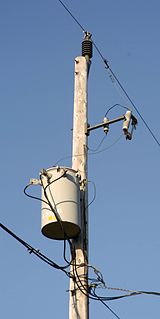 W
WIn electrical engineering, single-phase electric power is the distribution of alternating current electric power using a system in which all the voltages of the supply vary in unison. Single-phase distribution is used when loads are mostly lighting and heating, with few large electric motors. A single-phase supply connected to an alternating current electric motor does not produce a rotating magnetic field; single-phase motors need additional circuits for starting, and such motors are uncommon above 10 kW in rating.
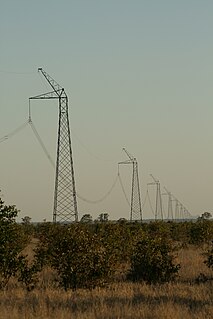 W
WSingle-wire earth return (SWER) or single-wire ground return is a single-wire transmission line which supplies single-phase electric power from an electrical grid to remote areas at low cost. Its distinguishing feature is that the earth is used as the return path for the current, to avoid the need for a second wire to act as a return path.
 W
WA smart meter is an electronic device that records information such as consumption of electric energy, voltage levels, current, and power factor. Smart meters communicate the information to the consumer for greater clarity of consumption behavior, and electricity suppliers for system monitoring and customer billing. Smart meters typically record energy near real-time, and report regularly, short intervals throughout the day. Smart meters enable two-way communication between the meter and the central system. Such an advanced metering infrastructure (AMI) differs from automatic meter reading (AMR) in that it enables two-way communication between the meter and the supplier. Communications from the meter to the network may be wireless, or via fixed wired connections such as power line carrier (PLC). Wireless communication options in common use include cellular communications, Wi-Fi, wireless ad hoc networks over Wi-Fi, wireless mesh networks, low power long-range wireless (LoRa), ZigBee, and Wi-SUN.
 W
WA split-phase or single-phase three-wire system is a type of single-phase electric power distribution. It is the alternating current (AC) equivalent of the original Edison Machine Works three-wire direct-current system. Its primary advantage is that it saves conductor material over a single-ended single-phase system, while only requiring a single phase on the supply side of the distribution transformer.
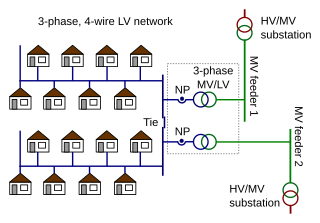 W
WIn electricity distribution networks, spot network substations are used in interconnected distribution networks. They have the secondary network with all supply transformers bussed together on the secondary side at one location. Spot networks are considered the most reliable and most flexible arrangement of connecting power to all types of loads. Switching can be done without interrupting the power to the loads.
 W
WA strain insulator is an electrical insulator that is designed to work in mechanical tension (strain), to withstand the pull of a suspended electrical wire or cable. They are used in overhead electrical wiring, to support radio antennas and overhead power lines. A strain insulator may be inserted between two lengths of wire to isolate them electrically from each other while maintaining a mechanical connection, or where a wire attaches to a pole or tower, to transmit the pull of the wire to the support while insulating it electrically. Strain insulators were first used in telegraph systems in the mid 19th century.
 W
WA third rail, also known as a live rail, electric rail or conductor rail, is a method of providing electric power to a railway locomotive or train, through a semi-continuous rigid conductor placed alongside or between the rails of a railway track. It is used typically in a mass transit or rapid transit system, which has alignments in its own corridors, fully or almost fully segregated from the outside environment. Third rail systems are always supplied from direct current electricity.
 W
WA traction network or traction power network is an electricity grid for the supply of electrified rail networks. The installation of a separate traction network generally is done only if the railway in question uses alternating current (AC) with a frequency lower than that of the national grid, such as in Germany, Austria and Switzerland.
 W
WA transient recovery voltage (TRV) for high-voltage circuit breakers is the voltage that appears across the terminals after current interruption. It is a critical parameter for fault interruption by a high-voltage circuit breaker, its characteristics can lead either to a successful current interruption or to a failure.
 W
WA utility pole is a column or post used to support overhead power lines and various other public utilities, such as electrical cable, fiber optic cable, and related equipment such as transformers and street lights. It can be referred to as a transmission pole, telephone pole, telecommunication pole, power pole, hydro pole, telegraph pole, or telegraph post, depending on its application. A Stobie pole is a multi-purpose pole made of two steel joists held apart by a slab of concrete in the middle, generally found in South Australia.
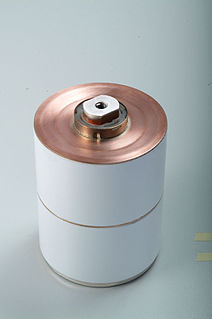 W
WIn electrical engineering, a vacuum interrupter is a switch which uses electrical contacts in a vacuum. It is the core component of medium-voltage circuit-breakers, generator circuit-breakers, and high-voltage circuit-breakers. Separation of the electrical contacts results in a metal vapour arc, which is quickly extinguished. Vacuum interrupters are widely used in utility power transmission systems, power generation unit, and power-distribution systems for railways, arc furnace applications, and industrial plants.
The Value of Lost Load (VoLL) is the estimated amount that customers receiving electricity with firm contracts would be willing to pay to avoid a disruption in their electricity service. The value of these losses can be expressed as a customer damage function (CDF). A CDF is defined as:
 W
WVariable renewable energy (VRE) is a renewable energy source that is non-dispatchable due to its fluctuating nature, like wind power and solar power, as opposed to a controllable renewable energy source such as dammed hydroelectricity, or biomass, or a relatively constant source such as geothermal power.
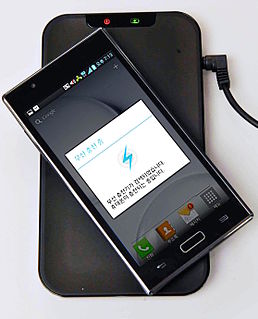 W
WWireless power transfer (WPT), wireless power transmission, wireless energy transmission (WET), or electromagnetic power transfer is the transmission of electrical energy without wires as a physical link. In a wireless power transmission system, a transmitter device, driven by electric power from a power source, generates a time-varying electromagnetic field, which transmits power across space to a receiver device, which extracts power from the field and supplies it to an electrical load. The technology of wireless power transmission can eliminate the use of the wires and batteries, thus increasing the mobility, convenience, and safety of an electronic device for all users. Wireless power transfer is useful to power electrical devices where interconnecting wires are inconvenient, hazardous, or are not possible.
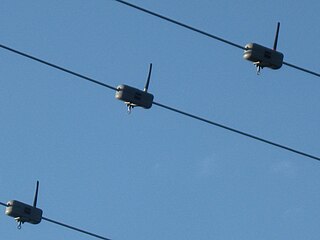 W
WA Wireless powerline sensor hangs from an overhead power line and sends measurements to a data collection system. Because the sensor does not contact anything but a single live conductor, no high-voltage isolation is needed. The sensor, installed simply by clamping it around a conductor, powers itself from energy scavenged from electrical or magnetic fields surrounding the conductor being measured. Overhead power line monitoring helps distribution system operators provide reliable service at optimized cost.